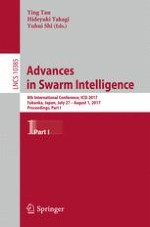The two-volume set of LNCS 10385 and 10386, constitutes the proceedings of the 8th International Confrence on Advances in Swarm Intelligence, ICSI 2017, held in Fukuoka, Japan, in July/August 2017.
The total of 133 papers presented in these volumes was carefully reviewed and selected from 267 submissions. The paper were organized in topical sections as follows:
Part I: theories and models of swarm intelligence; novel swarm-based optimization algorithms; particle swarm optimization; applications of particle swarm optimization; ant colony optimization; artificial bee colony algorithms; genetic algorithms; differential evolution; fireworks algorithm; brain storm optimization algorithm; cuckoo searh; and firefly algorithm. Part II: multi-objective optimization; portfolio optimization; community detection; multi-agent systems and swarm robotics; hybrid optimization algorithms and applications; fuzzy and swarm approach; clustering and forecast; classification and detection; planning and routing problems; dialog system applications; robotic control; and other applications.
